Keynotes
Prof. Vibeke Sorensen (Nanyang Technological University, Singapore) – Global Visual Music: from Audio-Video Synthesis to Transmodal Transmedia Art
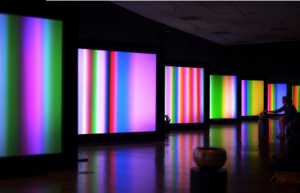 In the early 1970s Vibeke Sorensen imagined a Global Visual Music, an emergent, performative and compositional transmodal meta-medium that would allow individuals and ensembles located around the world and in many cultures, to collaboratively produce, perform, and interact with immersive images, spaces, sounds, music, and multi-sensory data in real-time. As the electromagnetic spectrum contains both sound and light, she explored waveforms as a common structural element for music and moving images. She considered engagement with the real-time process a form of meditation on nature and the universe. She worked with electronic systems such as the Rutt/Etra video and Moog audio synthesizers, composing and performing music as well as producing animation. By the mid-1980s, she was creating performances and installations with integrated analogue-digital systems such as the EAB video synthesizer, Apple, Amiga and other computers. She collaborated on the development of 2D paint, 3D modelling and animation software, producing stereoscopic and multi-monitor visual-music works. By the 1990s, her artworks had become ‘multi-‘ and employed digital video and sound, immersive interactive spatial imaging, 2D and 3D computer animation, networks, non-linear and parallel processes, and a wide range of custom devices. The common digital foundation had finally allowed her to integrate media and modalities previously considered distinct. In 1997, she received a 3-year research grant from Intel Corporation for the Global Visual Music Project as PI, to collaborate with computer musician Miller Puckette to develop the Graphics Extensions for Multimedia (GEM) for his open source computer music software, Pure Data. Working with composer Rand Steiger, and with the technical assistance of Mark Danks, they added video, image processing, 2D and 3D graphics, stereoscopy, physical computing, wireless, and networking, and conceived and produced a series of artworks that include immersive transmedia installations and live visual music performances connecting cities and continents. Today, her work employs plant biofeedback, social media, and ‘big data’. Having worked in Singapore since 2009, it is also informed by Asian culture and cosmologies. This talk will review her historical trajectory and discuss the relationship between her early work in synthesis and technologies available today.
In the early 1970s Vibeke Sorensen imagined a Global Visual Music, an emergent, performative and compositional transmodal meta-medium that would allow individuals and ensembles located around the world and in many cultures, to collaboratively produce, perform, and interact with immersive images, spaces, sounds, music, and multi-sensory data in real-time. As the electromagnetic spectrum contains both sound and light, she explored waveforms as a common structural element for music and moving images. She considered engagement with the real-time process a form of meditation on nature and the universe. She worked with electronic systems such as the Rutt/Etra video and Moog audio synthesizers, composing and performing music as well as producing animation. By the mid-1980s, she was creating performances and installations with integrated analogue-digital systems such as the EAB video synthesizer, Apple, Amiga and other computers. She collaborated on the development of 2D paint, 3D modelling and animation software, producing stereoscopic and multi-monitor visual-music works. By the 1990s, her artworks had become ‘multi-‘ and employed digital video and sound, immersive interactive spatial imaging, 2D and 3D computer animation, networks, non-linear and parallel processes, and a wide range of custom devices. The common digital foundation had finally allowed her to integrate media and modalities previously considered distinct. In 1997, she received a 3-year research grant from Intel Corporation for the Global Visual Music Project as PI, to collaborate with computer musician Miller Puckette to develop the Graphics Extensions for Multimedia (GEM) for his open source computer music software, Pure Data. Working with composer Rand Steiger, and with the technical assistance of Mark Danks, they added video, image processing, 2D and 3D graphics, stereoscopy, physical computing, wireless, and networking, and conceived and produced a series of artworks that include immersive transmedia installations and live visual music performances connecting cities and continents. Today, her work employs plant biofeedback, social media, and ‘big data’. Having worked in Singapore since 2009, it is also informed by Asian culture and cosmologies. This talk will review her historical trajectory and discuss the relationship between her early work in synthesis and technologies available today.
Biography
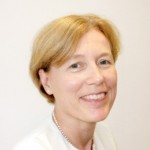 Vibeke Sorensen is an artist, composer, and professor working in digital multimedia and animation, stereography, interactive architectural installation, and networked visual music performance. Her work in experimental new media spans more than four decades and has been published and exhibited worldwide, including in books, galleries, museums, conferences, performances, film festivals, on cable and broadcast television, and the internet.
Vibeke Sorensen is an artist, composer, and professor working in digital multimedia and animation, stereography, interactive architectural installation, and networked visual music performance. Her work in experimental new media spans more than four decades and has been published and exhibited worldwide, including in books, galleries, museums, conferences, performances, film festivals, on cable and broadcast television, and the internet.
Since 1980, she taught and developed programs in media art at Virginia Commonwealth University, Art Center College of Design, California Institute of the Arts, and Princeton University. From 1984-94, she was Founding Director of the Computer Animation Laboratory in the School of Film/Video at the California Institute of the Arts (CalArts), and from 1994-2005 she was Professor and Founding Chair of the Division of Animation and Digital Arts (DADA) in the School of Cinematic Arts at the University of Southern California (USC). Since 2009, she has been Professor and Chair of the School of Art, Design and Media (ADM) at Nanyang Technological University (NTU) in Singapore.
Vibeke Sorensen has a long history of interdisciplinary collaborations, art-science and art-engineering interactions, including the development of new media technologies at Rensselaer Polytechnic Institute, Princeton University, the University of Southern California, the University of California San Diego / San Diego Supercomputer Center, the Neurosciences Institute of La Jolla, and the California Institute of Technology. Her research and creative work has been supported by USC, NTU, the New York State Council on the Arts, the US National Science Foundation, and Intel Corporation, among others. She is a 2001 Rockefeller Foundation Fellow in Film/Video/Multimedia. In 2007 she was the Chair of the ACM SIGGRAPH Art Gallery: Global Eyes.
Her recent work Illuminations (2013) is a large scale illuminated folding screen, an interactive visual-music installation incorporating plant biofeedback, ubiquitous computing, and electro-acoustic music that she composed. Vishwaroop (2014) is a 4K generative dome animation with music by sitar virtuoso Kartik Seshadri, and Mood of the Planet (2015) is a kinetic light-sound sculpture incorporating global, real-time big data, Twitter, and music composed by Sorensen. Her most recent work, Mayur (2015), with music by Kartik Seshadri, is a 4K animation inspired by Asian textiles, symbols, and cosmologies.
Joost Rekveld – A Palimpsest on the Electronic Analog Art: analogue computing and interactive exploration
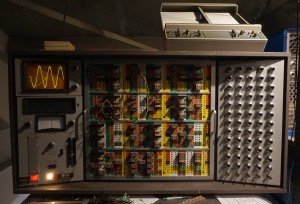 Analogue computers were in common use between 1950 and 1975; they made supersonic airplanes, missiles and nuclear reactors possible, calculated Dutch flood defenses and helped put man on the moon. Despite this, current histories of computing hardly mention analogue computing or omit it altogether, and present a curiously linear account of progress. In his keynote, Joost Rekveld will link different strata of the history of analogue computing to past and future potentials in the audiovisual arts. The thinking of generations of scientists and engineers was informed by practices of electronic simulation, in which physical analogies were enlisted to make electronic models that mostly worked in real-time. Tools developed for interactive exploration largely remained electronic until personal computers became ubiquitous in the eighties of the last century. There are many links between these analogue simulators and the early history of electronic instruments that were developed for the audiovisual arts, and the analogue computer can be regarded as the forgotten ancestor of the modular synthesizer in both audio and video.
Analogue computers were in common use between 1950 and 1975; they made supersonic airplanes, missiles and nuclear reactors possible, calculated Dutch flood defenses and helped put man on the moon. Despite this, current histories of computing hardly mention analogue computing or omit it altogether, and present a curiously linear account of progress. In his keynote, Joost Rekveld will link different strata of the history of analogue computing to past and future potentials in the audiovisual arts. The thinking of generations of scientists and engineers was informed by practices of electronic simulation, in which physical analogies were enlisted to make electronic models that mostly worked in real-time. Tools developed for interactive exploration largely remained electronic until personal computers became ubiquitous in the eighties of the last century. There are many links between these analogue simulators and the early history of electronic instruments that were developed for the audiovisual arts, and the analogue computer can be regarded as the forgotten ancestor of the modular synthesizer in both audio and video.
Even though much of this culture of interactive simulation has been subsumed into software tools such as graphical programming languages for real-time systems, there is currently a renewed interest in analogue instruments. Current scientific interest in analogue computing often relates to its status as an alternative computing paradigm and an alternative approach to the relation between physical processes and computation. A similar openness to material alternatives seems to be driving some of the current revival of analogue electronic tools in the arts.
Biography
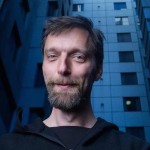 Joost Rekveld is an artist who is motivated by the question of what we can learn from a dialogue with machines. In his work, he explores the sensory consequences of systems of his own design, often inspired by forgotten corners in the history of science and technology. His films, installations and live performances are composed documentaries of the worlds opened by such systems. In their sensuality they are an attempt to reach an intimate and embodied understanding of our technological world.
Joost Rekveld is an artist who is motivated by the question of what we can learn from a dialogue with machines. In his work, he explores the sensory consequences of systems of his own design, often inspired by forgotten corners in the history of science and technology. His films, installations and live performances are composed documentaries of the worlds opened by such systems. In their sensuality they are an attempt to reach an intimate and embodied understanding of our technological world.
His abstract films have been shown world-wide in a wide range of festivals and venues for experimental film, animation or other kinds of moving image. He has realized several installations and was involved in many collaborative projects with composers, music ensembles, theatre companies, dance companies and artist’s labs.
Since 1991, Rekveld has had a long history of curating programmes of abstract animation and visual music, the most ambitious of which was the Sonic Light 2003 festival in Amsterdam. He has been giving lectures since 1993, has been teaching interdisciplinary art since 1996, and from 2008 to 2014 he was the course director of the ArtScience Interfaculty of the Royal Conservatoire and the Royal Academy of Art in The Hague. He is a board member of Sonic Acts (Amsterdam) and of the Centre for Visual Music (Los Angeles).
Dr Margaret Schedel (Stony Brook University, US) – Sounding Sight: synthesizing sound from image
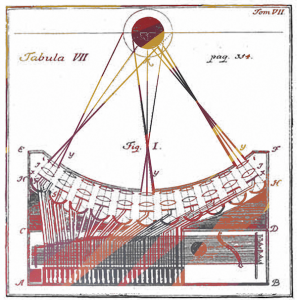 Voltaire once wrote the “secret analogy between light and sound leads one to suspect that all things in nature have their hidden rapports, which perhaps some day will be discovered.” Voltaire was undoubtably influenced by his correspondence with the inventor of the Ocular Organ, Louis Bertrand Castel. Although it was never built, the ocular organ can be seen as a prototypical synesthetic algorithmic instrument, meant to generate visual and sonic material simultaneously. The difference between analogy and transcoding is subtle; “normally analogy is about establishing partial equivalence between two different entities [while] transcoding is a sort of extreme analogy, where we establish complete correspondence based on transformations between entities.” (McDonald 2007). I will present case studies of pieces which cover the spectrum (pun intended) of techniques and methods used to transcode ocular data into auditory signals. Some of these algorithms are simple analog electro-mechanical devices, while others are complex programs that perform calculations, process data and make logical, or even illogical, decisions.
Voltaire once wrote the “secret analogy between light and sound leads one to suspect that all things in nature have their hidden rapports, which perhaps some day will be discovered.” Voltaire was undoubtably influenced by his correspondence with the inventor of the Ocular Organ, Louis Bertrand Castel. Although it was never built, the ocular organ can be seen as a prototypical synesthetic algorithmic instrument, meant to generate visual and sonic material simultaneously. The difference between analogy and transcoding is subtle; “normally analogy is about establishing partial equivalence between two different entities [while] transcoding is a sort of extreme analogy, where we establish complete correspondence based on transformations between entities.” (McDonald 2007). I will present case studies of pieces which cover the spectrum (pun intended) of techniques and methods used to transcode ocular data into auditory signals. Some of these algorithms are simple analog electro-mechanical devices, while others are complex programs that perform calculations, process data and make logical, or even illogical, decisions.
Biography
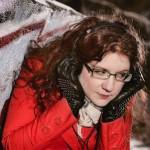 Margaret Anne Schedel is a composer and cellist specializing in the creation and performance of ferociously interactive media whose works have been performed throughout the United States and abroad. As an Associate Professor of Music at Stony Brook University, she serves as Co-Director of Computer Music and is the Director of cDACT, the consortium for digital arts, culture and technology. She ran SUNY’s first Coursera Massive Open Online Course (MOOC), an introduction to computational arts. Schedel holds a certificate in Deep Listening and is a joint author of Cambridge Press’s Electronic Music. She recently edited an issue of Organised Sound on the aesthetics of sonification and her two of her pieces are featured on the REACT recording by Parma Records. Her work has been supported by the Presser Foundation, Centro Mexicano para la Música y les Artes Sonoras, and Meet the Composer. She has been commissioned by the Princeton Laptop Orchestra the percussion ensemble Ictus, and the reACT duo. Her research focuses on gesture in music, the sustainability of technology in art, and sonification of data. She sits on the boards of 60×60, the International Computer Music Association, is a regional editor for Organised Sound and an editor for Cogent Arts and Humanities. In her spare time she curates exhibitions focusing on the intersection of art, science, new media, and sound.
Margaret Anne Schedel is a composer and cellist specializing in the creation and performance of ferociously interactive media whose works have been performed throughout the United States and abroad. As an Associate Professor of Music at Stony Brook University, she serves as Co-Director of Computer Music and is the Director of cDACT, the consortium for digital arts, culture and technology. She ran SUNY’s first Coursera Massive Open Online Course (MOOC), an introduction to computational arts. Schedel holds a certificate in Deep Listening and is a joint author of Cambridge Press’s Electronic Music. She recently edited an issue of Organised Sound on the aesthetics of sonification and her two of her pieces are featured on the REACT recording by Parma Records. Her work has been supported by the Presser Foundation, Centro Mexicano para la Música y les Artes Sonoras, and Meet the Composer. She has been commissioned by the Princeton Laptop Orchestra the percussion ensemble Ictus, and the reACT duo. Her research focuses on gesture in music, the sustainability of technology in art, and sonification of data. She sits on the boards of 60×60, the International Computer Music Association, is a regional editor for Organised Sound and an editor for Cogent Arts and Humanities. In her spare time she curates exhibitions focusing on the intersection of art, science, new media, and sound.
Papers
Dr Bret Battey (De Montfort University) – Mapping Hindustani-Vocalist Motions to Abstract Visuals
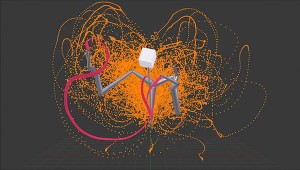 The practice of audiovisual composition arguably could gain from the development of audiovisual counterpoint pedagogy, theory and models. Battey discusses his own idea of ‘fluid audiovisual counterpoint’ through the lens of a project to map the motions of a Hindustani vocal performer to abstract visuals. The research investigates how the spontaneous, parallel discourse of the hand and upper-body motion of classical Indian vocal performers can provide new insights into how we can establish indirect but non-arbitrary relationships between sound an image.
The practice of audiovisual composition arguably could gain from the development of audiovisual counterpoint pedagogy, theory and models. Battey discusses his own idea of ‘fluid audiovisual counterpoint’ through the lens of a project to map the motions of a Hindustani vocal performer to abstract visuals. The research investigates how the spontaneous, parallel discourse of the hand and upper-body motion of classical Indian vocal performers can provide new insights into how we can establish indirect but non-arbitrary relationships between sound an image.
Biography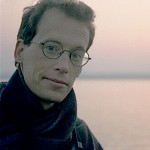
Bret Battey (b. 1967) creates electronic, acoustic, and multimedia concert works and installations. He has been a Fulbright Fellow to India and a MacDowell Colony Fellow, and he has received recognitions and prizes from Austria’s Prix Ars Electronica, France’s Bourges Concours International de Musique Electroacoustique, Spain’s Punto y Raya Festival and MuVi4, Abstracta Cinema of Rome, Amsterdam Film eXperience and the Texas Fresh Minds Festival for his sound and image compositions. He studied composition and electronic music at Oberlin Conservatory and the University of Washington and is a Reader with the Music, Technology, and Innovation Research Centre at De Montfort University, Leicester, UK.
Prof. Fred Collopy (Case Western Reserve University, US) – The Modernists’ Impulse Toward a Musical Art of Light
For a century, modern artists have turned to color and to light itself as raw materials with which to shape “new illusions,” to draw on one of Guillaume Apollinaire’s definitions of art. And they have often relied on music, with its abstract character, its rhythms and temporality, and its own forms and colors for inspiration. In 1913 Apollinaire opened a brief essay reflecting on 19th century impressionism, one wing of which “soars toward the sublime, light.” With modernism painting had moved from an art of reproduction to one of creation, aimed at “attaining the fullness of poetry in the bright light.” That Apollinaire delighted in these developments is not surprising. He was attuned to “the coming of an art that would be to painting what music is to literature.” He had identified Loie Fuller as “the great artist of line and color” and was a prominent and enthusiastic supporter of Leopold Survage’s Colored Rhythms. By 1923 the art critic Willard Huntington-Wright wrote of light as the ideal medium for abstract art, though he cautioned that the art would remain inferior until the emergence of an artist “great enough to express the profound form of a Rubens, or a Michelangelo or a Beethoven through this modern medium of light.” In this talk I explore ideas developed by these early modernists and some more recent ones with an eye to how their thoughts, creations, and experiments might inform the design of instruments and experiences for a new generation of visual musicians.
Biography
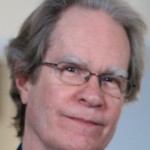 Fred Collopy is a Professor of Design and Innovation at Case Western Reserve University and a designer of computer-based instruments. Over four decades he has designed and led development of several large systems including The Desk Organizer (among the first personal digital assistants when it was published in 1980), TimeScope (an expert system for business and economic forecasting), Business Animator (an experiment in presenting financial analysis without numeric representations) and Imager (a visual music instrument). He released Unauthorized Duets, a collection of abstract videos, in 2000 and was the co-editor of Managing as Designing, published by Stanford University Press in 2004. His research has been widely published including in Leonardo, Glimpse, the IEEE Symposium on Visual Languages, and the Journal of Visual Programming Languages. He has served as a visiting scientist in the Computer Music Center at IBM’s Thomas J. Watson Research Center and at Cornell University’s Department of Communication.
Fred Collopy is a Professor of Design and Innovation at Case Western Reserve University and a designer of computer-based instruments. Over four decades he has designed and led development of several large systems including The Desk Organizer (among the first personal digital assistants when it was published in 1980), TimeScope (an expert system for business and economic forecasting), Business Animator (an experiment in presenting financial analysis without numeric representations) and Imager (a visual music instrument). He released Unauthorized Duets, a collection of abstract videos, in 2000 and was the co-editor of Managing as Designing, published by Stanford University Press in 2004. His research has been widely published including in Leonardo, Glimpse, the IEEE Symposium on Visual Languages, and the Journal of Visual Programming Languages. He has served as a visiting scientist in the Computer Music Center at IBM’s Thomas J. Watson Research Center and at Cornell University’s Department of Communication.
Karel Doing (University of the Arts London / London College of Communication) – Aeolian agency and eco-mimesis in expanded cinema
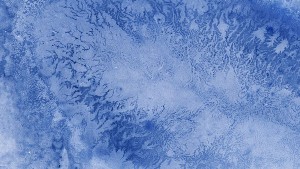 The aim of expanded cinema is often described in terms of activating the audience in the production of meaning. But, additional to this process, many expanded cinema works also intentionally or unintentionally re/create an environment. Here, the great tradition of landscape filmmaking overlaps with expanded cinema, and shares with it a desire to evoke an experience beyond the picture frame. By using Timothy Morton’s description and analyses of eco-mimesis in art, seminal expanded cinema works by Chris Welsby, William Raban, Tony Hill and Anthony McCall are looked at again.
The aim of expanded cinema is often described in terms of activating the audience in the production of meaning. But, additional to this process, many expanded cinema works also intentionally or unintentionally re/create an environment. Here, the great tradition of landscape filmmaking overlaps with expanded cinema, and shares with it a desire to evoke an experience beyond the picture frame. By using Timothy Morton’s description and analyses of eco-mimesis in art, seminal expanded cinema works by Chris Welsby, William Raban, Tony Hill and Anthony McCall are looked at again.
Parallel to this, analogue film-material has recently enjoyed a renewed popularity among artists and experimental filmmakers. This rebirth often focuses on the materiality and tactility of film itself. Besides the well known practice of scratching, painting and deteriorating film emulsion, new materials and methods have emerged. Caffenol developer made from simple house-hold products is now widely used by these practitioners, and in its wake more experimentation with organic materials and fluids is following suit. After the rayogram and the chemogram, the organigram appears.
Practical examples of these techniques show how concrete processes can produce abstract images and patterns. Through a series of experiments this process is further enriched and the results are organised into intricate compositions. What first appeared as unreadable noise is now translated into a language that can be read by musicians and audience.
Biography
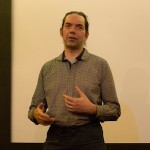 Karel Doing (1965, Canberra, Australia) is an artist and filmmaker who has worked extensively across analogue and digital formats. He is a media polyglot with a particular interest in the semiotics of film and expanded cinema. He is driven to reconnect implausible links: urban/nature, music/maths, passion/ratio, analogue/digital. After being based in Arnhem and Rotterdam (the Netherlands), he now lives and works in London. He is currently pursuing a PhD at the University of the Arts London about expanded cinema and critical posthumanism.
Karel Doing (1965, Canberra, Australia) is an artist and filmmaker who has worked extensively across analogue and digital formats. He is a media polyglot with a particular interest in the semiotics of film and expanded cinema. He is driven to reconnect implausible links: urban/nature, music/maths, passion/ratio, analogue/digital. After being based in Arnhem and Rotterdam (the Netherlands), he now lives and works in London. He is currently pursuing a PhD at the University of the Arts London about expanded cinema and critical posthumanism.
Ireti Olowe (Queen Mary University of London) – Audio to Visual Mapping of Moments and Variations
This paper presents an affect of Wassily Kandinsky’s and Paul Klee’s models of mapping on sound visualization. Kandinsky’s Point and Line to Plane and Klee’s Pedagogical Sketchbook provide archived philosophies of mapping, which stimulated and influenced the confluence of sound and image.
Visual interpretations of music have the potential to augment the listening experience by appending an additional modality — vision to audition. Mapping links between sonic characteristics of music in the audio domain to graphic attributes within the visual domain through which the effects of latter parameters are controlled by the behavior of the former, is primarily at the discretion of the practitioner. Research discussions about mapping implementations have mostly been a focus of instrument design. Computational music and audiovisual composition during which dynamic, bidirectional relationships are created between generative algorithms, audio production and image propagation and, unidirectional mapping relationships — from sound to image — have been less documented.
Utilizing principles developed by Kandinsky and Klee to establish movement in image, this presentation will explore an impact of mapping that investigates how relationships between sound and image can be interpreted through variations of musical form.
Biography
Ireti Olowe is a researcher who is interested in the abstractions of common observances and the stochastic results of natural occurrences. She is interested in pushing the boundaries of perception and investigating its limits spatially and cognitively.
Stewart Collinson, Dr Andrea Szigetvári (University of Lincoln, Liszt F. Academy of Music, Budapest) – ‘Sonokinos’: Some thinking on Syncing or syncing of thinking
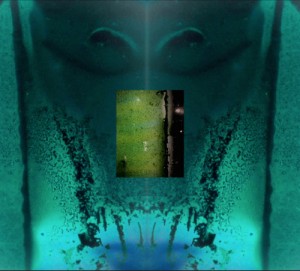 Eyemusic, visual music, or abstract cinema, are terms that carry an implicit hierarchy of value. We use the palindrome “sonikinos” to describe the collaborative sound-film work, “Transitus Angeli”, (Andrea Szigetvári/Stewart Collinson, 2014), in an attempt to address/equalize this super/sub/ordinate relationship. Through the use of this portmanteau-word, we attempt to reflect on, articulate, and define both the work, Transitus Angeli, in particular, and the processes in which it was created, through reference to the concept of Gestalt, analysing the work with reference to Eisenstein and Bohm, Chion’s concept, “point of synchronisation”, with it’s origins in Lacan’s “point de capiton”, and the creative possibility of slippage in “loose synchronism” or as we might call it, a “cloud of synchronisation”. We try to extend the concepts of gesture and texture, as defined in Smalley’s spectromophology, to the audiovisual domain.
Eyemusic, visual music, or abstract cinema, are terms that carry an implicit hierarchy of value. We use the palindrome “sonikinos” to describe the collaborative sound-film work, “Transitus Angeli”, (Andrea Szigetvári/Stewart Collinson, 2014), in an attempt to address/equalize this super/sub/ordinate relationship. Through the use of this portmanteau-word, we attempt to reflect on, articulate, and define both the work, Transitus Angeli, in particular, and the processes in which it was created, through reference to the concept of Gestalt, analysing the work with reference to Eisenstein and Bohm, Chion’s concept, “point of synchronisation”, with it’s origins in Lacan’s “point de capiton”, and the creative possibility of slippage in “loose synchronism” or as we might call it, a “cloud of synchronisation”. We try to extend the concepts of gesture and texture, as defined in Smalley’s spectromophology, to the audiovisual domain.
The notion of an interaction “between” elements is crucial but almost imperceptible or intangible. This imperceptibility indicates a problem of holding the “between” in thought. Barad’s concept of “intra-action” suggests (a) possible way(s) of resolution.
Biographies
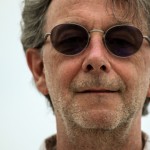 Stewart Collinson
Stewart Collinson
is an artist making moving-image work for single-screen, gallery installation and live-performance. Collaboratively, he creates audio/visual work in national and international contexts. He is primarily interested in the interaction of sound and image as a manifestation of collaborative process. He is senior lecturer in moving image on the BA (Hons) Photography and MA Fine Art programmes in the College of Arts at Lincoln University, UK.
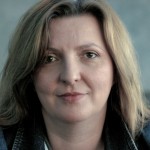 Andrea Szigetvári
Andrea Szigetvári
is an electroacoustic music composer. Her creative and research interests are timbre in new music, interactive performance, and synchresis in audiovisual art. She studied in Warsaw and then as a Fulbright scholar in the USA, returning to Hungary to set up the Hungarian Computer Music Foundation. In addition to composing, she lectures on computer music composition and has organized international new music festivals, conferences and pan-european projects. She won the Prize at the Bourges Electroacoustic Competition in both Sound Art and Multimedia categories in 2001. She holds a doctorate degree (DLA) in composition completed at the Liszt Ferenc Academy of Music, Budapest.
Bryan Dunphy (Goldsmiths, University of London) – Towards an Understanding of Contemporary Audiovisual Art
The space within which AV art resides is difficult to identify, not least because of the multitude of methodologies and combinations of media used in the practice of the art form. The development of AV practice has far outgrown the critical discourse or analysis surrounding contemporary work. I propose to identify a cross section of current work in the field that reflects the disparate media and methodologies currently employed by AV artists. I will then contextualise and critically analyse these works, suggesting an approach to understanding drawing on recent work in embodiment theory to try to gain an insight into the experience of AV art. Through a deeper understanding of how these pieces are experienced by the audio-viewer we may be able to identify the core of what AV art is to us. I argue that AV art currently occupies a space that straddles many different disciplines and forms without retaining an independent identity for itself. In identifying where the field of AV art lies through the analysis of contemporary practice, rather than placing a restrictive label on the art form, we will be able to understand more fully its underlying essence.
Biography
Bryan Dunphy is an Irish audiovisual artist, composer and performer based in London. His background is in music having received a B.Mus from NUI Maynooth before completing an M.Phil in Music and Media Technologies from Trinity College Dublin. He has performed as a member of musical groups across Ireland, the UK, Europe and China. As an AV artist and composer he has had his work performed and screened at venues such as the Kevin Barry Room (National Concert Hall, Dublin), the Samuel Beckett Theatre, the Darklight Film Festival and Slices of Life Festival. It was during his years at TCD that he was turned on to the expressive possibilities of audio and visuals when combined in a purposeful and meaningful way. He is interested in exploring the embodied experience of AV art and the development of a critical understanding of contemporary practices.
Yati Durant (University of Edinburgh) – Spontaneous Composition for Screen: A brief overview and observations on preliminary methods in practice with linear and non-linear improvisation for instruments and electronics
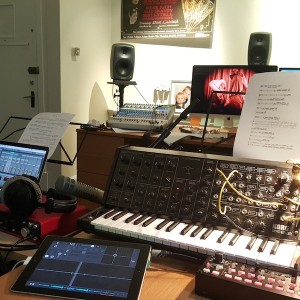 This paper discusses research that examines non-traditional music performance and composition practices utilising experimental electronic and acoustic performance strategies for scoring films. It looks at innovation within screen sound by examining how technological practices, both innovative and more established, are facilitating and shaping the creative processes of screen composition and sound design. At the forefront of this research is taking into account new forms of electronic and musician interface to the improvisation process when composing in real time, which includes controllers that manipulate sound in real time, musical gesture and notation for live performance, and new compositional structure as pertains to dramatic flow when working to picture.
This paper discusses research that examines non-traditional music performance and composition practices utilising experimental electronic and acoustic performance strategies for scoring films. It looks at innovation within screen sound by examining how technological practices, both innovative and more established, are facilitating and shaping the creative processes of screen composition and sound design. At the forefront of this research is taking into account new forms of electronic and musician interface to the improvisation process when composing in real time, which includes controllers that manipulate sound in real time, musical gesture and notation for live performance, and new compositional structure as pertains to dramatic flow when working to picture.
There has been much history with combining musical improvisation to film, however effects of improvisation also need to be looked at from a compositional perspective. Preliminary research suggests that dramatic emphasis in music for screen is more complex than is commonly understood, with Lipscomb and Kendall’s Film Music Paradigm (1994, Perceptual judgment of the relationship between musical and visual components in film. Psychomusicology, 13(Spring/Fall), p.91) presenting a viewpoint that congruency relationships considerably alter our perception of what music “fits” to film. At the same time, musical improvisation, with it’s dynamic reactibility and spontaneity, provides a potential to experiment more deeply within these musical borders. And, since composing is often a more (but not always) specifically structured working process than improvisation, it must be looked at that certain forms of improvisation can be considered analogous to composition methods.
Utilizing 5 main differentiations of improvisational approach to music to film, this paper aims to consider the effects of this reactibility, dramatic control and spontaneity while accessing the impact and potential these new processes will have on traditional views associated with film scoring, composition and performance. Will they work to further expand modern scoring practices to increase its effectiveness, or will they simply dilute otherwise clear and congruent compositional processes?
Biography
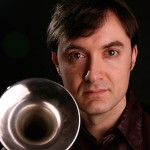 Yati Durant is a U.S. born composer, lecturer, trumpeter and conductor currently based in the UK.
Yati Durant is a U.S. born composer, lecturer, trumpeter and conductor currently based in the UK.
His musical background began with composition and jazz music from the age of 7. He was founding member of the experimental jazz ensemble Honey Junkie and The Yati Durant Project Band in the 1990s. He studied with Portland trumpeter (and Grammy winner) Thara Memory before moving to New York, where he began a successful stint as a TV and film music composer.
Yati holds a Diploma and prestigious Konzertexam Meisterklasse in composition from the Polish composer Krzysztof Meyer at the State Conservatory of Music in Cologne, Germany, as well as a Diploma in Electronic Composition under Hans Ulrich Humpert. He has also studied with George Crumb, Philip Lasser, Narcis Bonet, Lee Konitz and conducting with Jonathan Brett.
His compositions and films have received many prizes from International festivals, including a 3rd Pl. Panorama Public Prize at the 2008 Berlin International Film Festival for Erika Rabau – Der Puck von Berlin and a BAFA National Commerce Film Award nomination for the WDR/ARD documentary Ein Klavier geht um die Welt. He is a finalist of the 2009 Concorso Giovani Musicisti Europei in Aosta, Italy with his score to C. Chaplin’s The Vagabond. His contemporary compositions have been commissioned and performed in New York, Seattle, Berlin, Edinburgh, Cologne and Sao Paolo, released on CD and DVD by Film Dienst/Normal Records, Filmmuseum München and he remains an active performer of jazz, with regular appearances and recordings throughout Europe and USA.
Since 2010, Yati is Lecturer and Programme Director of MSc Composition for Screen at the Reid School of Music, University of Edinburgh and Artistic Director of the Edinburgh Film Music Orchestra. He is Director of the European Education Alliance for Music and Sound in Media (EEAMS) at Soundtrack Cologne and Festival International du Film d’Aubagne.
Joe Banks – J.G. Ballard, Ultrasonic Visual Music, William Hogarth and The Analysis of Beauty
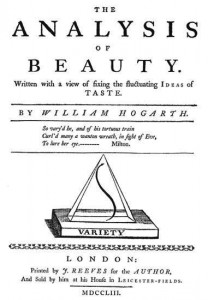 The paper is based on a presentation originally delivered to accompany “The Analysis of Beauty” – a sound and light installation by art project Disinformation – exhibited in the Georgian Gallery at Talbot Rice (Edinburgh) in Nov 2014. The installation derives its title from the book of the same name, which was self-published by the artist William Hogarth in 1753. In “The Analysis of Beauty” William Hogarth explored the imagery, aesthetics and symbolism of the waving, curved, or (as Hogarth put it) “Serpentine” line, which in modern language we refer to as the sine-wave; and the installation interprets Hogarth’s ideas in context of contemporary sound art. In the installation, musical sine-waves are fed into and visualised on the screen of a laboratory oscilloscope, with the signals manifesting as a slowly rotating rope-like pattern of phosphorescent green lines; the effect was described as “mesmerising” by Aesthetica Magazine. The paper discusses “The Analysis of Beauty” installation in relation to the concept of “ultrasonic visual music” described by the science-fiction author J.G. Ballard, in his short story “The Sound Sweep”, and discusses the vivid and spontaneously self-contradicting illusions produced by viewing this artwork, in relation to J.G. Ballard’s description of the (quote) “central nervous system (as) nature’s Sistine Chapel”, as described in J.G. Ballard’s book “The Kindness of Women”. [216 words]
The paper is based on a presentation originally delivered to accompany “The Analysis of Beauty” – a sound and light installation by art project Disinformation – exhibited in the Georgian Gallery at Talbot Rice (Edinburgh) in Nov 2014. The installation derives its title from the book of the same name, which was self-published by the artist William Hogarth in 1753. In “The Analysis of Beauty” William Hogarth explored the imagery, aesthetics and symbolism of the waving, curved, or (as Hogarth put it) “Serpentine” line, which in modern language we refer to as the sine-wave; and the installation interprets Hogarth’s ideas in context of contemporary sound art. In the installation, musical sine-waves are fed into and visualised on the screen of a laboratory oscilloscope, with the signals manifesting as a slowly rotating rope-like pattern of phosphorescent green lines; the effect was described as “mesmerising” by Aesthetica Magazine. The paper discusses “The Analysis of Beauty” installation in relation to the concept of “ultrasonic visual music” described by the science-fiction author J.G. Ballard, in his short story “The Sound Sweep”, and discusses the vivid and spontaneously self-contradicting illusions produced by viewing this artwork, in relation to J.G. Ballard’s description of the (quote) “central nervous system (as) nature’s Sistine Chapel”, as described in J.G. Ballard’s book “The Kindness of Women”. [216 words]
Biography
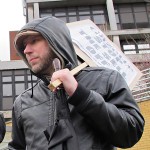 Joe Banks is the founder of Disinformation – a sound, video and kinetic art project, which, since 1995, produced a series of pioneering experimental music and installation art works, using natural and man-made electromagnetic (radio) noise, radiated by live mains electricity, lightning, industrial and IT hardware, railway and metro (tube) systems, and even the sun. Disinformation has recorded 8 commercially published CDs and LPs, performed more than 100 concerts, exhibited in over 40 gallery exhibitions, and been the subject of 15 solo exhibitions. Disinformation published the “R&D2” CD in 1998, featuring Very Low Frequency radio noise from Eurostar trains, and the “Sense Data & Perception” CD in 2005, featuring VLF noise from the London Underground system and from Network South East trains.
Joe Banks is the founder of Disinformation – a sound, video and kinetic art project, which, since 1995, produced a series of pioneering experimental music and installation art works, using natural and man-made electromagnetic (radio) noise, radiated by live mains electricity, lightning, industrial and IT hardware, railway and metro (tube) systems, and even the sun. Disinformation has recorded 8 commercially published CDs and LPs, performed more than 100 concerts, exhibited in over 40 gallery exhibitions, and been the subject of 15 solo exhibitions. Disinformation published the “R&D2” CD in 1998, featuring Very Low Frequency radio noise from Eurostar trains, and the “Sense Data & Perception” CD in 2005, featuring VLF noise from the London Underground system and from Network South East trains.
Joe Banks is also author of the book “Rorschach Audio – Art & Illusion for Sound” – a monograph on the psychology of interpretation of audible speech and distorted voice recordings, which was published as the final outcome of a 5-year research project sponsored by The Arts & Humanities Research Council. Joe has written for Art Monthly, for Cabinet and Shoppinghour magazines, for Strange Attractor Journal, and Leonardo Music Journal (published by The MIT Press). Rorschach Audio lecture-demonstrations have been presented at The British Library, The Science Museum Dana Centre, The Royal College of Art, The ICA, Goldsmiths College, University of Westminster, City University & Freud Museum (London), the Liverpool Biennale, Universities of Leeds and Edinburgh, FHNW (Basel), Argos (Brussels), Arteleku (San Sebastian), Gertrude Contemporary and MUMA (Melbourne).
Pablo Perez Zarate (Bath Spa University) – Expanding Minds with Visual Music
Focusing on Expanded Cinema practices and theory, this paper examines the relationship between psychedelic lightshows and contemporary VJ practice whilst exploring analogies between expanded cinema’s technologically utopic visions and current Globalization theory. The case study of Digital Cumbia is used to illustrate these ideas and looks at the role of the VJ in disseminating a new visual identity for Latin America through its participation in multimedia immersive performances.
Keywords: Expanded Cinema, psychedelic lightshows, VJ culture, Latin America
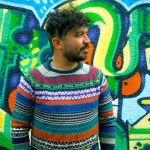 Biography
Biography
Pablo Perezzarate is an audio-visual artist of dual Mexican-British nationalities living in Bristol, UK. His work explores the crossover between installation, performance and social documentary through the creation of immersive environments. Under the name Panther Panther he produces Latin American inspired electronic dance music that he represents visually through live multi-sensory performances. He graduated in 2006 from the Music and Visual Arts undergraduate course at Brighton University. In 2013 he finished his Creative Sound & Media Technology Masters Degree at Bath Spa University where he has continued with a PhD on Expanded Cinema, Globalization and Visual Music. He has published two academic articles, “Landscaping the Global Imagination” with the Bristol-based journal HARTS & Minds and “Expanding Minds with Visual Music” through the Universidade de Brasilia for the international conference Understanding Visual Music in 2015. Pablo is a lecturer at Bristol Institute of Modern Music.
Dr David J. Brown, Jane Pitt, Dr. Michael J. Proulx (University of Bath) – Seeing with Sound: sensory substitution and sonification as trans-disciplinary tools for Sci-Art collaborative research
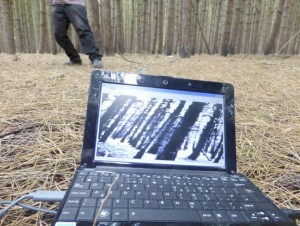 Sensory substitution devices for the visually impaired provide the missing visual input by converting images into a format that another sense can process, such as sound. These devices have been instrumental in providing key insights into neural plasticity and the functional neuroanatomy of blindness. A number of applications have been assessed, as well, from visual acuity to recognizing letters to spatial navigation. Some blind expert users even experience visual qualia while listening to the output of a device (The vOICe) after extensive use. Here our joint presentation describes work in the field of sensory substitution for visual rehabilitation, cross-modal collaboration and trans-disciplinary research interpreting place and space through sonification and sound artworks. Through examples of the Crossmodal Cognition Lab’s research work with sighted and blind users of a sensory substitution device The vOICe (SSD) we demonstrate the basic concepts of how this SSD translates live digital image into a fixed sonic language and how people can learn this language. While our project Trans-space outlines an innovative approach and context for contemporary audio visual work using sensory substitution and sensory deprivation as tools to inform artistic practice. Applying practice led scientific and creative research to trans-disciplinary Audio-Visual experiments and digital artworks. Considering the semantics of sound and the potential for translating or interpreting our experience and perceptions of place & space mediated through sound.
Sensory substitution devices for the visually impaired provide the missing visual input by converting images into a format that another sense can process, such as sound. These devices have been instrumental in providing key insights into neural plasticity and the functional neuroanatomy of blindness. A number of applications have been assessed, as well, from visual acuity to recognizing letters to spatial navigation. Some blind expert users even experience visual qualia while listening to the output of a device (The vOICe) after extensive use. Here our joint presentation describes work in the field of sensory substitution for visual rehabilitation, cross-modal collaboration and trans-disciplinary research interpreting place and space through sonification and sound artworks. Through examples of the Crossmodal Cognition Lab’s research work with sighted and blind users of a sensory substitution device The vOICe (SSD) we demonstrate the basic concepts of how this SSD translates live digital image into a fixed sonic language and how people can learn this language. While our project Trans-space outlines an innovative approach and context for contemporary audio visual work using sensory substitution and sensory deprivation as tools to inform artistic practice. Applying practice led scientific and creative research to trans-disciplinary Audio-Visual experiments and digital artworks. Considering the semantics of sound and the potential for translating or interpreting our experience and perceptions of place & space mediated through sound.
Biographies
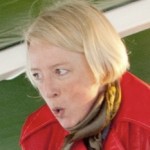 Jane Pitt is an interdisciplinary artist with a particular focus on sound & multi-sensory perception. Making work nationally and internationally through commissions and residencies in response to sites as well as in active participation with the public in public spaces; on land, water and in mobile vehicles. She received the first Arts Council England International Fellowship for Outdoor Arts in 2003. Recent sound art works include: ‘Sonic Sharabang’ 2015, ‘Don’t tickle me..PUNCH!’ for Art Transmission BRFM & Resonance FM 2014; ‘KlangPortal’, Wiesbaden Kunstsommer Biennale 2014; ‘Radiozound’ temporary radio station onboard LV21 2012 etc..For an overview of her work visit: www.janepitt.co.uk/proj.html She is currently developing her extended listening, vocalising & soundmapping practice while involved in research projects with cognitive scientist Dr Michael Proulx and with Scottish composer Claire Docherty.
Jane Pitt is an interdisciplinary artist with a particular focus on sound & multi-sensory perception. Making work nationally and internationally through commissions and residencies in response to sites as well as in active participation with the public in public spaces; on land, water and in mobile vehicles. She received the first Arts Council England International Fellowship for Outdoor Arts in 2003. Recent sound art works include: ‘Sonic Sharabang’ 2015, ‘Don’t tickle me..PUNCH!’ for Art Transmission BRFM & Resonance FM 2014; ‘KlangPortal’, Wiesbaden Kunstsommer Biennale 2014; ‘Radiozound’ temporary radio station onboard LV21 2012 etc..For an overview of her work visit: www.janepitt.co.uk/proj.html She is currently developing her extended listening, vocalising & soundmapping practice while involved in research projects with cognitive scientist Dr Michael Proulx and with Scottish composer Claire Docherty.
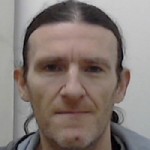 Dr Dave Brown is a cognitive psychologist in the Crossmodal Cognition Lab at the University of Bath. His PhD at Queen Mary University of London focused on visual-to-auditory sensory substitution assessing devices which convert visual information to auditory soundscapes utilised to provide visual percepts to users with sensory impairments. He has published in numerous scientific journals, given talks at national and international conferences, and interviews for a variety of media outlets. Examples of recent research in multisensory perception have included topics such as information capacity limits in sonified object recognition, perception of affect in haptic and sonified signals, and perceptual learning. He also has an interest in whisky – from a scientific perspective naturally.
Dr Dave Brown is a cognitive psychologist in the Crossmodal Cognition Lab at the University of Bath. His PhD at Queen Mary University of London focused on visual-to-auditory sensory substitution assessing devices which convert visual information to auditory soundscapes utilised to provide visual percepts to users with sensory impairments. He has published in numerous scientific journals, given talks at national and international conferences, and interviews for a variety of media outlets. Examples of recent research in multisensory perception have included topics such as information capacity limits in sonified object recognition, perception of affect in haptic and sonified signals, and perceptual learning. He also has an interest in whisky – from a scientific perspective naturally.
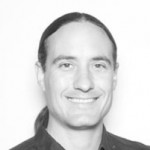 Dr Michael J. Proulx is Associate Professor of Psychology and director of the Crossmodal Cognition Lab at the University of Bath. His research focuses on several aspects of crossmodal cognition and multisensory processes with a particular interest in the impact of blindness on cognition and the development of assistive devices for visual impairment. He received his BSc in Psychology from Arizona State University and his PhD in Psychological and Brain Sciences from Johns Hopkins University. He is a Fellow of the Society of Experimental Psychology and Cognitive Science and of the American Psychological Association.
Dr Michael J. Proulx is Associate Professor of Psychology and director of the Crossmodal Cognition Lab at the University of Bath. His research focuses on several aspects of crossmodal cognition and multisensory processes with a particular interest in the impact of blindness on cognition and the development of assistive devices for visual impairment. He received his BSc in Psychology from Arizona State University and his PhD in Psychological and Brain Sciences from Johns Hopkins University. He is a Fellow of the Society of Experimental Psychology and Cognitive Science and of the American Psychological Association.
Dr Lewis Sykes (Manchester Metropolitan University) – Touch: See: Hear
Supported by an AHRC Cultural Engagement Fellowship, this 13-week, full-time project (February-April 2016) aims to prototype a bespoke, interactive environment for users of the LEVEL Centre – a multimedia arts space in Rowsley, Derbyshire, UK. More than just an immersive multi-sensory experience, this is a distinct art work with a purpose – a tool for individual and group audiovisual composition.
While LEVEL has a wealth of experience and expertise in ‘guided’ creative activities they also have a remit to develop ‘autonomous’ multimedia and creative technologies. Accordingly, they’ve recently initiated the ‘Inter-ACT + Re-ACT’ programme – simple, interactive installations (a current example is a digital ‘hall of mirrors’) that engage people through their journey around the building. No instructions are given and staff just observe the level of reaction and engagement to try and work out who does what and why. Touch:See:Hear responds to key questions raised through this emerging programming – “How might learning disabled adults engage with playful multi-media and multi-sensory environments embedded into the fabric of the building?” and “What unique benefits might this type of activity realise?”
This paper outlines development of the project to date, highlighting: research and theory that informed its conception; issues of interaction and usability; its emerging aesthetics; and key stages within an iterative design process that applies a User Centred Design approach (including significant user testing and analysis) to the development of the installation – all informed through LEVEL’s unique appreciation of the nature of learning disabled adult’s ‘usual’ engagement with interactive multimedia and creative technologies.
Biography
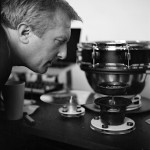 Lewis Sykes is a visual musician, creative technologist, researcher/educator and digital media producer/curator based in Manchester, UK.
Lewis Sykes is a visual musician, creative technologist, researcher/educator and digital media producer/curator based in Manchester, UK.
A veteran bass player of the underground dub-dance scene of the 90s he performed and recorded with Emperor Sly and Radical Dance Faction and was a partner in Zip Dog Records.
Co-ordinator of the ‘digital futures think tank’ Cybersalon (2002-2007) – founding Artists-in-Residence at the Science Museum’s Dana Centre – he was also Director of Cybersonica, an annual celebration of music, sound art and technology launched at the Institute of Contemporary Arts (ICA), London, UK (2002-11).
Honing an interest in mixed media through an MA Hypermedia Studies at the University of Westminster (2000) he continued to fuse music, visuals and technology through creative collaborations – most notably as musician with the progressive audiovisual collective The Sancho Plan (2005-2008) – performing and exhibiting interactive audiovisual sets and sonic installations at numerous UK and European festivals. Currently as a member of Monomatic he explores sound and interaction and the interplay between music and image through physical works, creative software and audiovisual performances.
A doctoral graduate from MIRIAD, Manchester Metropolitan University since February 2015, his Practice as Research Ph.D. – The Augmented Tonoscope – explored the aesthetics of sound and vibration. His research interests in multi-sensory perception and audiovisual composition techniques which attempt to engage our senses in a way which is not discretely seen and heard – but is instead ‘co-sensed’ or ‘seenheard’ – has led to a current focus on ‘designing for difference’ – the development of interactive environments and assistive technologies for people with disabilities.
lewissykes.info
phd.lewissykes.info
Victoria Oruwari and Marie Cécile Embleton – The Colours of Sound
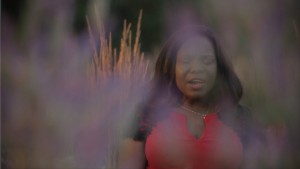 Victoria Oruwari and Marie-Cécile Embleton present a scene-in-the-making for a documentary film currently in production, The Colours of Sound (working title) – a creative documentary that explores three blind muscians’ unique relationships to music and sound. Director of the film, Marie-Cécile Embleton, will introduce the film. Award-winning soprano, Victoria Oruwari, will perform an aria from Tosca accompanied by Kevin Satizabal on the piano. A creative experimental scene of Victoria singing Tosca is being developed for the film and will form a part of Victoria’s colourful syneasthetic perception of the world brought to the screen.
Victoria Oruwari and Marie-Cécile Embleton present a scene-in-the-making for a documentary film currently in production, The Colours of Sound (working title) – a creative documentary that explores three blind muscians’ unique relationships to music and sound. Director of the film, Marie-Cécile Embleton, will introduce the film. Award-winning soprano, Victoria Oruwari, will perform an aria from Tosca accompanied by Kevin Satizabal on the piano. A creative experimental scene of Victoria singing Tosca is being developed for the film and will form a part of Victoria’s colourful syneasthetic perception of the world brought to the screen.
Biographies
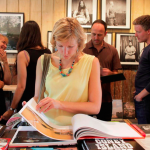 Marie-Cécile Embleton is a filmmaker whose documentary films explore how people’s creative practices shape and inform their perceptions of the world. She has worked as a director of photography and assistant producer on documentaries made for broadcasters such as BBC, YLE (Finland) and RAI (Italy). In 2012 she worked as a director of photography on the feature documentary ‘The Cuban Wives’ which was selected for three international film festivals and won the Malvinas award at the 27th Trieste Latin American Film Festival. In 2011 she was commissioned by the Norwegian Embassy to do a photo reportage story on witchcraft in Malawi. In 2015 she filmed and directed her first short documentary ‘The Watchmaker’. She is currently directing a creative documentary ‘The Colours of Sound’.
Marie-Cécile Embleton is a filmmaker whose documentary films explore how people’s creative practices shape and inform their perceptions of the world. She has worked as a director of photography and assistant producer on documentaries made for broadcasters such as BBC, YLE (Finland) and RAI (Italy). In 2012 she worked as a director of photography on the feature documentary ‘The Cuban Wives’ which was selected for three international film festivals and won the Malvinas award at the 27th Trieste Latin American Film Festival. In 2011 she was commissioned by the Norwegian Embassy to do a photo reportage story on witchcraft in Malawi. In 2015 she filmed and directed her first short documentary ‘The Watchmaker’. She is currently directing a creative documentary ‘The Colours of Sound’.
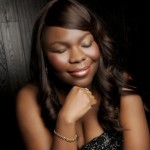 An award winning Soprano, Victoria Oruwari is a frequent recitalist in and out of the UK. She has performed at various venues including Kensington Palace, Agip recital hall Lagos, The viaduct events centre Auckland, The Ferrari museum Italy, the royal festival hall, King’s place London, Colston Hall Bristol, and Mansion house. She is also a song writer, a singing teacher and choir director in London. Victoria’s broad repertoire covers early Classical, modern Musical theatre, Gospel, traditional Folk songs and Jazz. Victoria was the soloist for BBC music day 2015 where she performed on the one show with the british Paraorchestra, the signing choir and the Bristol youth choir. In February 2016, Victoria sang a duet with Jarvis cocker accompanied by Charles Hazelwood’s all star collective as part of the BBC six music festival.
An award winning Soprano, Victoria Oruwari is a frequent recitalist in and out of the UK. She has performed at various venues including Kensington Palace, Agip recital hall Lagos, The viaduct events centre Auckland, The Ferrari museum Italy, the royal festival hall, King’s place London, Colston Hall Bristol, and Mansion house. She is also a song writer, a singing teacher and choir director in London. Victoria’s broad repertoire covers early Classical, modern Musical theatre, Gospel, traditional Folk songs and Jazz. Victoria was the soloist for BBC music day 2015 where she performed on the one show with the british Paraorchestra, the signing choir and the Bristol youth choir. In February 2016, Victoria sang a duet with Jarvis cocker accompanied by Charles Hazelwood’s all star collective as part of the BBC six music festival.
Victoria recently collaborated with sculptor and installation artist Tabatha Andrews in a powerful exhibition titled “amongst remote lost objects” Which showed in London and Plymouth attracting a wide audience and raving reviews. Victoria is a member of the Inner Vision orchestra: (An orchestra of highly skilled blind musicians who tour the UK yearly). She has also formed a collaboration with Kevin Satizabal, a Pianist/composer. Together they have performed at venues including Grosvenor chapel, The institute of Education to open the visually impaired musicians lives conference, and Colston hall Bristol with the Inner vision Orchestra. Victoria’s many awards include: The Paul Simm Opera Prize, The Elizabeth Eagle Bott Memorial Scholarship Award, The Newman Thomas Commonwealth Award and the Eva Noreen Student Scholarship. For more information, or to book Victoria for an event, please visit www.victoriaoruwari.com – to hear Victoria sing, Visit www.victoriaoruwari.com/sounds
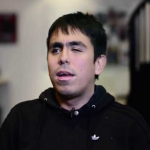 Kevin Satizabal was born in Popayan Colombia in 1990, and began his formal music education at the Royal College of Music Junior Department. He studied piano with Denise Patton, recorder with Sarah Humphreys, and composition with Avril Anderson. He graduated from Birmingham Conservatoire in 2012, studying composition with Richard Causton, Joe Cutler, Lamberto Coccioli and Edwin Roxburgh.
Kevin Satizabal was born in Popayan Colombia in 1990, and began his formal music education at the Royal College of Music Junior Department. He studied piano with Denise Patton, recorder with Sarah Humphreys, and composition with Avril Anderson. He graduated from Birmingham Conservatoire in 2012, studying composition with Richard Causton, Joe Cutler, Lamberto Coccioli and Edwin Roxburgh.
During his time at the Royal College Kevin won various competitions including the West London pianoforte festival, the Ealing festival, was a finalist at the Royal College Teresa Carreno competition, and performed at London’s Wigmore hall as one of the winners of the Jaques Samuel’s Junior Intercollegiate Piano Competition in 2007.
Alongside studying composition at Birmingham Conservatoire, Kevin also took up piano lessons under the tutorage of Jonathan French, culminating in a performance of the second piano concerto by Shostakovich in 2012.
Kevin has recently played as soloist and accompanist with singers and other instrumentalists in recitals throughout London, Northampton and Birmingham.
Dr Ryo Ikeshiro (London South Bank University) – Real-Time GENDYN Audiovisualisation
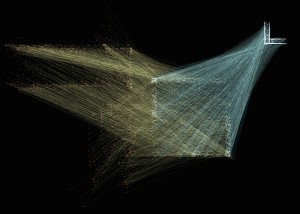 This is an ongoing project on the visualisation of a real-time implementation of Xenakis’s GENDYN, or its “audiovisualisation”. It aims to be functional both didactically – in depicting the processes behind dynamic stochastic synthesis – and aesthetically – in complementing the sounds produced so that it is suitable for use in an artistic context. The merits of the simultaneous visualisation and sonification of an abstract process such as Xenakis’ dynamic stochastic synthesis are introduced. The schemes used in the visualisation are then explained, and properties of GENDYN which become more apparent are discussed.
This is an ongoing project on the visualisation of a real-time implementation of Xenakis’s GENDYN, or its “audiovisualisation”. It aims to be functional both didactically – in depicting the processes behind dynamic stochastic synthesis – and aesthetically – in complementing the sounds produced so that it is suitable for use in an artistic context. The merits of the simultaneous visualisation and sonification of an abstract process such as Xenakis’ dynamic stochastic synthesis are introduced. The schemes used in the visualisation are then explained, and properties of GENDYN which become more apparent are discussed.
Biography
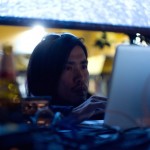 Ryo Ikeshiro is a UK-based Japanese artist whose practice deals with sound, media and computation. He is interested in the artistic potential of computational technology and algorithmic processes as well as the cultural and political dimension of computation and media and its critique within art.
Ryo Ikeshiro is a UK-based Japanese artist whose practice deals with sound, media and computation. He is interested in the artistic potential of computational technology and algorithmic processes as well as the cultural and political dimension of computation and media and its critique within art.
His output includes audiovisual performances, interactive installations, generative art, electronic music and various image formats including Teletext pages. Recent works explore issues of race, gender, identity, diversity and net culture through using computer vision, singing voice synthesis software, found footage, onomatopoeia and “sound symbolism”.
Ikeshiro has presented his works internationally in a wide range of contexts including exhibitions, festivals, concerts and screenings as well as academic conferences. He is featured in the Electronic Music volume of the Cambridge Introductions to Music series, he is a contributor to Sound Art: Sound as a medium of art, a forthcoming publication from ZKM Karlsruhe, and his articles have been published in the journal Organised Sound.
He has a PhD from Goldsmiths, University of London. The topic explored was real-time data sonification and visualisation – or live “audiovisualisation” – of emergent generative systems based on dynamical systems and fractals within the framework of audiovisual and computational art. He also works as a lecturer. Recently, he was an artist in residence at the Asia Culture Center in Gwangju, South Korea. He works as a lecturer at the School of Arts and Creative Industries in the London South Bank University.
Trent Kim (Royal College of Art) – Demystifying Body in Lumia via Embodied Simulation: Lumia after Thomas Wilfred
This paper reviews Thomas Wilfred’s 200 page unpublished document, ‘Lumia, the Art of Light’ and shares the researcher’s findings to contextualise his recently embarked PhD project at London’s Royal College of Art. The researcher argues that Lumia was a unique art form of light, strictly born within the context of colour music; therefore Wilfred’s claim that Lumia is the art of light as its purest form is effectively false. The vision of Lumia demystifies a bi-directional (or uni-directional) relationship between sound and light by rejecting any analogy theories, and promotes electrically charged silence as a counterpart to sound.
Overall, Lumia was an independent art form of light to be performed at a concert hall, and the art worked towards the concept of second field. The vision of Lumia sets out specific rules, but Lumia’s ambiguous relationship with music makes it difficult for one to label it. The researcher interprets Wilfred’s vision of Lumia into a research question: ‘Can electric light art evoke a perception of music without sound, and without establishing any analogies between sound and light in a performance context?’ and asks a further question in response: ‘Does body matter?’ The researcher suggests the concept of embodied simulation can be a new way to move our research on Lumia forward from Wilfred’s style of light art and his Clavilux development to materialising a post-Wilfred generation of Lumia art.
Biography
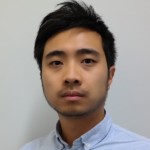 Trent Kim is a Glasgow based, Korean-Scottish light artist. Trent currently teaches at the Glasgow School of Art in the Masters of Research in Creative Practices, and he also studies at the Royal College of Art as a part time research student. His current research is inspired by the art of Lumia, a much-forgotten form of light art from the early 20th century. Through the writings and compositions of Thomas Wilfred, the founder of the art form, Trent experiments to re-contextualise the art into the present time.
Trent Kim is a Glasgow based, Korean-Scottish light artist. Trent currently teaches at the Glasgow School of Art in the Masters of Research in Creative Practices, and he also studies at the Royal College of Art as a part time research student. His current research is inspired by the art of Lumia, a much-forgotten form of light art from the early 20th century. Through the writings and compositions of Thomas Wilfred, the founder of the art form, Trent experiments to re-contextualise the art into the present time.
Dr Rob Mullender (London College of Communication) – Coding Bodies
This paper discusses the role of text and the voice (both external and internal) in the interplay between the histories of audio-visuality and in the histories of the senses and the arts. More specifically it will look at the emergence of modernist discourses centred on voice, the auditory and the visual, whereby the roles of text, sound and image were being radically reformulated under the auspices of Phonography and Film. In the last 15 years, scholars such as Smirnov, Kahn, Levin, Thoben and Naumann have traced exploratory audio-visual practices from the late 19th century to the present, often engaging with tropes surrounding the role of the apparatus-as-sensory-proxy. I will take a slightly different route in this regard, discussing how the metaphor of the machine-body extended into the realm of memory, language and aurality via Dada, Sound Poetry and Phonography. This will take the form of a Lecture performance, drawing together various media and combining these with a live auscultation sound work.
Biography
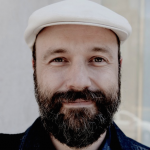 Rob produces sculptural, sound, 2D, performance and moving image works when he can, and occasionally records, designs and mixes sound for film. He produces sounding objects. Typically these take the form of sculptures which contain different analogue (as distinct from digital) or acoustic sound production techniques, which are readably and structurally part of the objects themselves. They are often then used to make a video or sound work, disrupting or colluding with the camera or recorder, articulating or modifying the surrounding space, be it physical and sensual, social and performed. Often, a performative aspect to his practice comes to the fore; pieces may require activation, or are contextually bound by relations with bodies and places. He thinks of these sculptural works as passing points, pieces of territory through which ideas and energy are changed and exchanged, or synthesisers which require the spectator’s attention for them to operate through his or her engagement as watcher, listener or even operator.
Rob produces sculptural, sound, 2D, performance and moving image works when he can, and occasionally records, designs and mixes sound for film. He produces sounding objects. Typically these take the form of sculptures which contain different analogue (as distinct from digital) or acoustic sound production techniques, which are readably and structurally part of the objects themselves. They are often then used to make a video or sound work, disrupting or colluding with the camera or recorder, articulating or modifying the surrounding space, be it physical and sensual, social and performed. Often, a performative aspect to his practice comes to the fore; pieces may require activation, or are contextually bound by relations with bodies and places. He thinks of these sculptural works as passing points, pieces of territory through which ideas and energy are changed and exchanged, or synthesisers which require the spectator’s attention for them to operate through his or her engagement as watcher, listener or even operator.
Most recently, Rob has performed Minor Conspiracy for adapted reed organ and eight breathing participants, and Happy Ending – a site specific (street based) intervention for improvising musicians and massage parlour TV screen. Rob received his PhD in 2011, which looked at how light could be used to synthesise sound, and teaches on the Live Events and Television, and Sound Arts and Design courses at the London College of Communication – part of UAL. As of April, he is a Leverhulme Artist in Residence at the Brunel Museum, in London.
Thierry Dilger – Visual representation as an analog component to sound creation
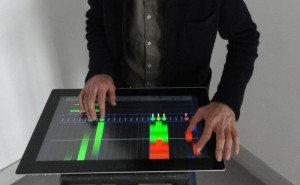 Through different works I have been involved in, I have always considered the visual representation as an intrinsic part of my creative process. But the beauty of this is that I consider visuals not as simple feedbacks to sounds but as a key element to produce sounds.
Through different works I have been involved in, I have always considered the visual representation as an intrinsic part of my creative process. But the beauty of this is that I consider visuals not as simple feedbacks to sounds but as a key element to produce sounds.
Through my personal experience, I have developed several approaches to sound composition, interactive installations, workshops even for babies. I have soon expressed the need to create my own tools and most of my developments so far are coming from a simple idea : using visuals for driving sounds.
GASPR is a surround sound composition platform I have created. It is built from a video game engine managing movement of colored sprites. The visual representation is the composition layer similar to a score. It represents a paradigm with 3 axes : relative time, sound output and sound intensity. Its unique approach gives the ability to embrace interactivity with sound structures, macro and micro time events, sound position in space… All are driven in real time by visuals in a analog way : if I delete visuals, there is no more sound.
Biography
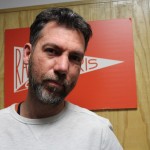
Thierry DILGER, freelance researcher / interactive designer / sound artist (1978), trained at ESRA – ISTS, CNAM – ENJMIN (national school of video games) and at IRCAM in 2000/2001 with the musical real time interactions team. He develops, since 2010, his own behavioral spatial sound tool : GASPR = Graphical Audio Spatialization Program.
This software and its associated paradigm has been introduced in several conferences worlwide including AES (Audio Engineering Society) Budapest Hungary, SAIC (School of Art Institute) Chicago USA, ICSA ( International Convention on Spatial Audio) Detmold Germany, JIM / Journées d’Informatique Musicale, Paris France, INTETAIN (Convention International Conference on Intelligent Technologies for Interactive Entertainment) Mons Belgium.
Meanwhile, he developed a pedagogical research for early childhood (children under 3 years) in interactive audio. He is head of interactive game audio department at ICAN (Video Game School, Paris). He is also a founding member and coordinator of the international sound competition Mixage Fou.
Dr Marko Ciciliani (University of Music and Performing Arts Graz, IEM – Institute of Electronic Music and Acoustics) – an introspective method for the analysis of musical multimedia
Approaches to the analysis of multimedia are relatively scarce and most of them focus on objectively verifiable aspects as synchrony of events in different media, or semantic correspondences between them. While these aspects are undoubtedly of high relevance for the perception of multimedia, they are not sufficient to reflect on the aesthetic impact of a work.
As several authors have argued, it is precisely the rather ephemeral effects that constitute the most fascinating side of multimedia, e.g. when sound “makes us see the image differently, and then this new image makes us hear the sound differently […]”.
The proposed paper tries to fill this methodological gap by describing a method for an introspective analysis of musical multimedia. Here, the focus lies on self-reflectively becoming aware of the effect that a given example of multimedia has and how this effect is achieved.
The method builds on terms that have been used for the description of multimedia by Cook (1996), Iwamiya (2013) and Kyriakides (2015). It takes the form of a semantic differential, where the impact of specific connotated factors of the work are differentiated and graphically indicated.. By differentiating factors of valence (good-bad), activity (active-passive) and potency (strong-weak) a better understanding can be achieved of how a given example is experienced by a subject.
Biography
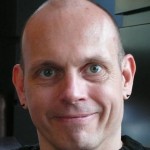 Marko Ciciliani (b. 1970, Zagreb) is a composer, audiovisual artist and researcher based in Austria. The focus of his work lies in the composition of performative electronic music, often in audiovisual contexts. Lighting, laserdesigns or the use of live-video are often integral parts of his compositions. The artistic combination of sound and light was also the topic of his PhD research that he completed at Brunel University London in 2010.
Marko Ciciliani (b. 1970, Zagreb) is a composer, audiovisual artist and researcher based in Austria. The focus of his work lies in the composition of performative electronic music, often in audiovisual contexts. Lighting, laserdesigns or the use of live-video are often integral parts of his compositions. The artistic combination of sound and light was also the topic of his PhD research that he completed at Brunel University London in 2010.
It is characteristic of Ciciliani’s compositions that sound is not only understood as abstract material but as a culturally shaped idiom. The exploration of a sound’s communicative potential is as much in the foreground of his work as its objective sonic quality. Ciciliani’s work is characterized by a conceptual approach in which aspects of classical composition, sound and media-studies play tightly together. His music has been performed in more than 35 countries in Europe, Asia, Oceania and the Americas.
Ciciliani is full Professor for Computer-Music Composition and Sound Design at the IEM – Institute for Electronic Music and Acoustics of the University of Music and Performing Arts Graz. His primary research topics are tightly related to his artistic work and revolve around methods of understanding and analyzing forms of multimedia, and performance practices. In 2015 Ciciliani has been granted funding for a 3 year artistic research project titled “GAPPP – Gamified Audiovisual Performance and Performance Practice”. It is funded as part of the PEEK program of the Austrian Science Fund and will run from 2016-19.
www.ciciliani.com
vimeo.com/channels/cicichannel
gappp.net
Kristina Wolfe (Brown University, US) – SOUND VISION: A Collection of Sonic Meditations
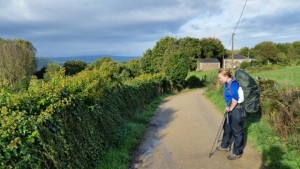 Every object in the environment both emits and reflects sound. Every material, as we know, reflects or resonates sound in a particular way. That is why we make walls from stone and use wood to build an organ and not the other way around. In our normal lives, things resonate and echo their presence like beams of sound that you can hear if only you pay attention to the qualities of the ambient silences.
Every object in the environment both emits and reflects sound. Every material, as we know, reflects or resonates sound in a particular way. That is why we make walls from stone and use wood to build an organ and not the other way around. In our normal lives, things resonate and echo their presence like beams of sound that you can hear if only you pay attention to the qualities of the ambient silences.
For example:
the low absorbent void of a tree or telephone pole
the high reflective shimmer of a rock face
the high-pitched-patchy glow of a holly bush
the spotty aliasing of a wooden fence
the absorbent shadow of the person in front of you
the openness of a mountainside looking down upon a valley
The enormous shadows of large objects like cliffs.
The crisp hiss of tree leaves
In ‘silence’ we can hear space.
This talk and the paper are intended as a “think-piece”, or a series of tasks that the listener can use to begin to practice sound vision— a kind of echolocation. It is a practice of awareness and not meant to be done at any particular time. The purpose of this talk and the resulting meditations are to learn the way the material composition of objects manifests itself in the ambient sound around the listener. The first part of the Sound Vision meditations handles listening to objects that are static and familiar to you. The second and third meditations outline a practice of coming to perceive contrasts and similarities of surfaces and objects. The fourth is a blind man’s walk.
Biography
Kristina Wolfe is a doctoral candidate in the Computer Music and Multimedia Program at Brown University (expected 2016). Her work deals with time (musical and historical), representation, and sonic spiritualism. She also works in instrument augmentation/extension, robotics, electronics, and alternative temperaments. Her pieces have been performed at many festivals, conferences, and concerts, including Darmstadt, Composit Festival, Third Practice Electro-Acoustic Festival, IAWM, and many International Computer Music Conferences. In 2007, she worked as the Greg Altman Media Intern at the Deep Listening Institute. In 2014, she was awarded honorable mention for the Pauline Oliveros prize by the Alliance for Women in Music.
Rolando Rodriguez, Jessica Arianne Rodriquez Cabrera (University of Arts, Aguascalientes, University of Guanajuato, Mexico) – Blending nomad sound and images
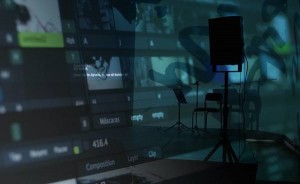 It’s true that we’re experiencing emerging artistic practices like: New Text, Generative Text, Landscapes Text, Expanded Cinema, and Expanded Readings. Are all of these new artistic expressions? I’d say no. Why? Because since the beginning mankind’s expanded and generated what we’ve called communication. From this perspective, the question about the relationship between sound and image emerges. As prehistoric men we always had a communication need. How did we get that communication? The answer seems simple: we used sound and images. It’s a fact that we didn’t have any specific language code as we already do. But we had guttural sounds, corporal gestures, and skills to use primitive technology to generate images like cave painting or petroglyphs. So, we didn’t use a language just like we do now. Sound and images were the most important skills as communications forms.
It’s true that we’re experiencing emerging artistic practices like: New Text, Generative Text, Landscapes Text, Expanded Cinema, and Expanded Readings. Are all of these new artistic expressions? I’d say no. Why? Because since the beginning mankind’s expanded and generated what we’ve called communication. From this perspective, the question about the relationship between sound and image emerges. As prehistoric men we always had a communication need. How did we get that communication? The answer seems simple: we used sound and images. It’s a fact that we didn’t have any specific language code as we already do. But we had guttural sounds, corporal gestures, and skills to use primitive technology to generate images like cave painting or petroglyphs. So, we didn’t use a language just like we do now. Sound and images were the most important skills as communications forms.
Today, we are bringing back those tribal expressions and updating them. It’s not nostalgic. It’s that we’re recovering what we already call “nomad image”. The image is nomad while is linked with sound. A sound is an image, because it’s been traveling and activating our collective and individual memory. We can lose the written language. For instance, we have Alexandrian Library. We can even lose the language by itself. Like when we were mute and deaf. But we do not lose our communication skill because we have to communicate each other. That’s how sound and images are dialoging today.
Biographies
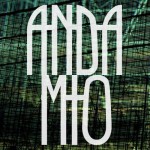 Rolando Rodríguez Guízar studied Education and Communication and currently finishes his Master in Contemporary Art at the University of Arts in Aguascalientes. He’s been writing and promoting cultural events, and producing his own artistic pieces. He’s won several writing contests in México, and making presentations about what he does. This year he was selected to make a presentation, a workshop, two researches and chat at the Image Festival in Manizales, Colombia in May, as well as, selected to present Mikrokosmica in Leeds, and a paper called: “LiveCoding, Algorithms viewed as Images, Sound and Text”. In Glasgow and Bath he was selected to present his new paper called: “Blending Nomad Sound and Images”, and in June, was selected to present the same paper and his piece called: “The Terrestrial Days”.
Rolando Rodríguez Guízar studied Education and Communication and currently finishes his Master in Contemporary Art at the University of Arts in Aguascalientes. He’s been writing and promoting cultural events, and producing his own artistic pieces. He’s won several writing contests in México, and making presentations about what he does. This year he was selected to make a presentation, a workshop, two researches and chat at the Image Festival in Manizales, Colombia in May, as well as, selected to present Mikrokosmica in Leeds, and a paper called: “LiveCoding, Algorithms viewed as Images, Sound and Text”. In Glasgow and Bath he was selected to present his new paper called: “Blending Nomad Sound and Images”, and in June, was selected to present the same paper and his piece called: “The Terrestrial Days”.
Jessica Arianne Rodríguez Cabrera studied Visual Arts at UMSNH, in Michoacán. Currently she’s taking her last semester studying her Master in Programming Music. She’s taken several workshops and certifications courses in programming codes for Art, Design, Cultural Management and Art. She’s been working on photo and mostly video, as well in researching. This year she was selected to make a presentation, a workshop, two researches and chat at the Image Festival in Manizales, Colombia in May. She was selected to present Mikrokosmica in Leeds, and a paper called: “LiveCoding, Algorithms viewed as Images, Sound and Text. In Glasgow and Bath he was selected to present her new paper called: “Blending Nomad Sound and Images”, and in June, was selected to present the same paper and her piece called: “The Terrestrial Days”.
James Snazell (Edge Hill University) – Reading Between The Lighterature
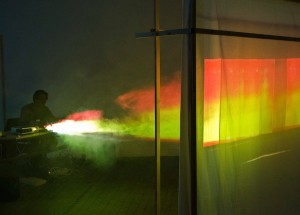 The work of LIGHTUNE G consisting of the Serbian collaborative duo Bojan Gagić and Miodrag Gladović and their project series “Lighterature” and also “Route 666” is based upon the conversion of light from luminous objects into tone images via the photovoltaic effect generated through solar panels. Viewing such work can lead to the question of how we can describe their work in terms of the name that defines their performance and composition technique – luminoacoustics. Is it a form of sculpture or audio-visual composition? Does it relate more to acoustics or optics and should we call it photovoltaic art?
The work of LIGHTUNE G consisting of the Serbian collaborative duo Bojan Gagić and Miodrag Gladović and their project series “Lighterature” and also “Route 666” is based upon the conversion of light from luminous objects into tone images via the photovoltaic effect generated through solar panels. Viewing such work can lead to the question of how we can describe their work in terms of the name that defines their performance and composition technique – luminoacoustics. Is it a form of sculpture or audio-visual composition? Does it relate more to acoustics or optics and should we call it photovoltaic art?
The work of LIGHTUNE G can be framed by looking at the analogue work of Bruce Mclure’s “modified projector performance” and Peter Kubelka’s sculptural 16mm film ‘Arnulf Rainer’, both these artists, like LIGHTUNE G look to utilise the basic elements of light, dark, sound and non-sound and they can be seen as analogue precursors to the work of LIGHTUNE G not least in the difficulty of how do we define this kind of work?
Biography
James Snazell is an experimental filmmaker who lives and works in Manchester. He creates and exhibits films that make use of mainly film but as well on occasion video techniques, treating the image and sound as elements of equal importance. He produces performative installation based work as well as single channel screen based work. He looks to create accidental elements within a rhythmic sequence through analogue film-material techniques and processes with a particular focus on manipulating and analysing the surface of film.
He currently teaches animation at Edge Hill University.
He is a part of the collective Film Material, a Manchester-based artist filmmaking group dedicated to experimental cinema.
Zata Banks – The PoetryFilm Archive: Sounds of Poetry and Poetry of Sounds
PoetryFilm is the influential research art project and screening series founded by Zata Banks in 2002, to celebrate experimental text/image/sound artworks, and to explore semiotics and meaning-making within the art form. PoetryFilm was founded through personal practice, and through an interest in the creation, communication, perception and experience of emotion and meaning. Since 2002, 90 screenings have been produced at cinemas, galleries, literary festivals and academic institutions – including Tate Britain, The ICA, Southbank Centre, Cannes Film Festival, CCCB Barcelona, O Miami, and Curzon Cinemas.
In addition, lecture-presentations include sessions for MA Creative Writing (Warwick University), MA Filmmaking (National Film & Television School), MA Visual Communication (Royal College of Art), BA Graphic Design (University of Lincoln) and a presentation for the Psychoanalysis Festival at the Freud Museum. This highly creative art form may be approached from a number of directions. At the Seeing Sound symposium, a selection of sound-informed artworks from the PoetryFilm Archive will be presented and discussed, including works by Julian Scordato, Stuart Pound and Monica Saviron.
In 2014, Arts Council England funded the archiving of the PoetryFilm collection, which at present contains over 1,000 artworks, and in 2015, Zata Banks worked with The British Film Institute to curate and produce 3 PoetryFilm Paradox events as part of the BFI Love season. PoetryFilm is one of the British Council’s listed Experimental Film organisations, is an accredited member of Film Hub London, part of the BFI Audience Network, and holds a trademark awarded by the Intellectual Property Office.
Biography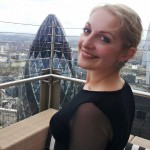
Film curator Zata Banks holds BA and MA degrees from Warwick University, where she studied literature, poetry, film, psychoanalysis and creative writing. Alongside curating PoetryFilm and developing personal creative projects, Zata Banks is a brand consultant working within the corporate branding and marketing industries. She usually lives in London though has just spent 3 months living near the Arctic Circle for an artist-research residency in association with the University of Iceland.
Christopher King – Electronic Video Practice in Britain
While experimental film & video work in Britain is generally well recorded, the sub-discipline of electronic video has not received the same attention here as it has in America or Europe. This may be due to several factors: relatively fewer artists working in the field, fewer facilities and a greater focus from practitioners and curators on other areas of experimental moving image practice. This paper seeks to bring together newly collected documentation on early British electronic video & video synthesis and to situate this work in a historical and international context. The work, dating from the late 1960s to the early 1980s, has been collected both directly from the artists themselves and from contemporary publications and catalogues.
Biography
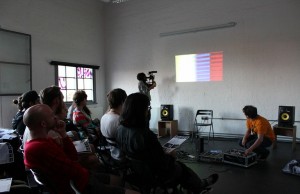
Christopher King collects and archives early media art periodicals. His blog and online discussion group video circuits explores early abstract and synthetic image making practices such as video synthesis, experimental animation, visual music, cymatics and graphic scores. Chris regularly performs live visual music using electronic video and audio synthesis techniques. He also teaches workshops on these techniques and the history and context of electronic intermedia and visual music practice.
Dr Mick Grierson (Goldsmiths, University of London) – Code Circle 2: An Online Platform for Coding Audiovisual Art
 Audiovisual Art often focuses on pattern making – sonically, visually and as an interaction between the two. Such patterns are not simply at the level of ‘events’. They are present in the textural qualities of periodic features. One of the most efficient and powerful ways of manipulating such features is through signal processing at the level of computer code. However, text-based coding is not always something we associate with an interactive, natural, creative process. Visual data-flow languages such as Max, Pure Data and VVVV are interactive, but it can be more challenging to create new buffer-level signal processing toolchains in visual data flow languages than it is to simply program them using traditional methods. So if text languages work, but the interaction method is poor, and if visual data flow environments have better interaction, but are not flexible enough to create novel signal processing, what should happen next?
Audiovisual Art often focuses on pattern making – sonically, visually and as an interaction between the two. Such patterns are not simply at the level of ‘events’. They are present in the textural qualities of periodic features. One of the most efficient and powerful ways of manipulating such features is through signal processing at the level of computer code. However, text-based coding is not always something we associate with an interactive, natural, creative process. Visual data-flow languages such as Max, Pure Data and VVVV are interactive, but it can be more challenging to create new buffer-level signal processing toolchains in visual data flow languages than it is to simply program them using traditional methods. So if text languages work, but the interaction method is poor, and if visual data flow environments have better interaction, but are not flexible enough to create novel signal processing, what should happen next?
Code Circle 2 is a browser-based HTML5 IDE with bug detection, real-time interactive rendering, and social features, designed to facilitate the creation of Audiovisual Art. Although similar platforms exist, Code Circle 2 uniquely fuses Interactive Programming with Collaborative Coding, providing interactive compilation alongside real-time social document editing in the browser. Users can work together on software that features accelerated computer graphics, buffer-level audio, signal processing, real-time user interfaces, and any other HTML5 / CSS3 / JavaScript compatible features they wish to use. Grierson will explicitly describe the motivation for the platform, show its capabilities, and discuss its future use.
Biography
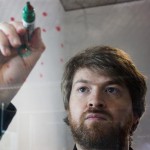 Mick Grierson is a Reader at Goldsmiths Department of Computing. During 2008-2015 he ran the Goldsmiths BSc in Creative Computing, Digital Arts Computing and the MA/MFA in Computational Arts. Grierson also played a large role in the creation and development of the Goldsmiths Music Computing programme. He is now programme leader for the Goldsmiths College MSci in Creative Computing and Computer Science.
Mick Grierson is a Reader at Goldsmiths Department of Computing. During 2008-2015 he ran the Goldsmiths BSc in Creative Computing, Digital Arts Computing and the MA/MFA in Computational Arts. Grierson also played a large role in the creation and development of the Goldsmiths Music Computing programme. He is now programme leader for the Goldsmiths College MSci in Creative Computing and Computer Science.
Grierson has been making experimental noise art since the late 1980s. He ceased musical activity in the mid 90s to become a filmmaker, and began producing experimental audiovisual art shortly after. He completed his PhD in Audiovisual Composition in 2005.
Grierson co-founded the Goldsmiths Embodied Audiovisual Interaction Group (EAVI) with Marco Gillies and Atau Tanaka. He is involved in a range of research in Creative Computing, including sound, graphics and interaction.
His involvement is central in some of the most noteworthy creative technology installations since 2010 including Christian Marclay’s internationally acclaimed “The Clock”, Heart n Soul’s “Dean Rodney Singers” (Part of the Paralympics Unlimited Festival), and Science Museum’s “From Oramics to Electronica”.
Grierson led the world’s first Massive Open Online Course (MOOC) in Creative Coding, which was also the first MOOC by any English University. Over 150,000 people enrolled. He also contributes to the Coursera specialization in Web Development, and has developed a new Kadenze MOOC on Audiovisual Programming.
Dr Andrew Hill (University of Greenwich) – Unpacking Audiovisual Phenomena
The ability of the human mind to perceive and interpret a diversity of audiovisual phenomena provides manifold opportunities for the composer to construct a diverse range of sound image associations. However, a constant desire resurfaces to codify the specific ways in which sounds and images might be combined and associated. These models are often founded upon drawing equivalencies between various parameters of sound and images.
This paper seeks to probe what drives this recurring desire and to unpack how this interest in audio-visual associations might be reframed within the context of audience perception. In doing so it seeks to demonstrate the challenges faced by explicit and codified rules of audiovisual association, and to open up the floor to more flexible and open frameworks informed by the act of perception itself.
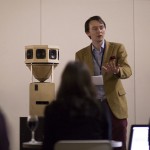 Biography
Biography
Andrew Hill (1986) is a composer of electroacoustic music, specialising in studio composed works both acousmatic (purely sound based) and audio-visual. His works have been performed extensively across the UK, as well as in Europe and the US.
His works are composed with materials captured from the human and natural world, seeking to explore the beauty in everyday objects.
His research investigates how we experience sound within different contexts, from sound with image, to locative media contexts and site specific concerts and performances.
Dr Dave Payling (Staffordshire University) – Interaction, Visual Composition and Synthesis with Quartz Composer
![DaveP_workImage[7KY4]](http://www.seeingsound.co.uk/wp-content/uploads/2020/11/DaveP_workImage7KY4-300x169-1.png) This paper gives an overview of my creative practice over the last 3 years, in particular focussing on the video synthesis and interaction techniques used in the compositions Diffraction, Circadian Echoes and a piece currently under development. It specifically discusses methods of synthesising animations in Quartz Composer. Quartz is a free visual programming language available in OS X, which is designed for processing and rendering graphical data, interactive motion graphics and video manipulation. It can be used to create real-time interactive applications and offers many tools for parametric mapping between sound and image. As a MAX/MSP and Jitter user, I will describe the relationship between both applications and discuss the influence Quartz has had on my creative outcomes with examples from my compositions.
This paper gives an overview of my creative practice over the last 3 years, in particular focussing on the video synthesis and interaction techniques used in the compositions Diffraction, Circadian Echoes and a piece currently under development. It specifically discusses methods of synthesising animations in Quartz Composer. Quartz is a free visual programming language available in OS X, which is designed for processing and rendering graphical data, interactive motion graphics and video manipulation. It can be used to create real-time interactive applications and offers many tools for parametric mapping between sound and image. As a MAX/MSP and Jitter user, I will describe the relationship between both applications and discuss the influence Quartz has had on my creative outcomes with examples from my compositions.
Biography
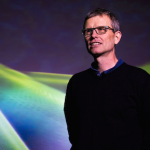 Dave has been a tutor in Music Technologies at Staffordshire University since 2001, teaching MAX/MSP, Quartz Composer, audio mastering and sound synthesis. He is a visual music composer and holds a PhD in Visual Music composition. His earlier research centred on sonification and auditory display and his composition ‘Listen (Awakening)’ was performed at the Sydney Opera House as part of the ICAD conference in 2004. His more recent work focuses on composition for Visual (Video) Music with an emphasis on electroacoustic composition and how this can be combined with abstract animation and video concrete. Dave also produces more mainstream electronic EDM music under the name of ‘PAYL’ and is looking at ways to integrate this more closely with his academic research.
Dave has been a tutor in Music Technologies at Staffordshire University since 2001, teaching MAX/MSP, Quartz Composer, audio mastering and sound synthesis. He is a visual music composer and holds a PhD in Visual Music composition. His earlier research centred on sonification and auditory display and his composition ‘Listen (Awakening)’ was performed at the Sydney Opera House as part of the ICAD conference in 2004. His more recent work focuses on composition for Visual (Video) Music with an emphasis on electroacoustic composition and how this can be combined with abstract animation and video concrete. Dave also produces more mainstream electronic EDM music under the name of ‘PAYL’ and is looking at ways to integrate this more closely with his academic research.
Dave’s video music compositions have been performed at the Soundings Festival Edinburgh, MANTIS Festival University of Manchester, flEXiff Experimental Film Festival Sydney Australia, Seeing Sound Bath Spa, NoiseFloor Festival Staffordshire and the Understanding Visual Music Conference in Brasilia, Brazil.
Brian Garbet (University of Calgary, CA) – Cymatic Representation of a “Mysterious” Noise Pollution
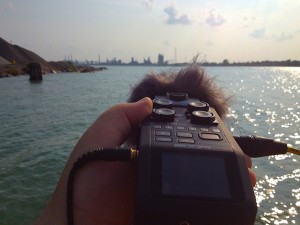 Noise pollution in the form of an intrusive low frequency hum is causing health and social problems for thousands of Canadian residents in the community of Windsor, Ontario. Over the past several decades there have been similar documented cases of intrusive hums that adversely impact a portion of the population in many industrialized countries. Regions affected by this type of noise pollution are found in other areas of Canada, as well as Australia, New Zealand, and the USA; and in the UK specifically, areas such as Bristol, Durham County, and London. Only recently have complaints of this particular type of noise pollution been taken seriously enough to warrant scientific studies, although the problem in the Windsor region has documented cases dating back to the 1950s.
Noise pollution in the form of an intrusive low frequency hum is causing health and social problems for thousands of Canadian residents in the community of Windsor, Ontario. Over the past several decades there have been similar documented cases of intrusive hums that adversely impact a portion of the population in many industrialized countries. Regions affected by this type of noise pollution are found in other areas of Canada, as well as Australia, New Zealand, and the USA; and in the UK specifically, areas such as Bristol, Durham County, and London. Only recently have complaints of this particular type of noise pollution been taken seriously enough to warrant scientific studies, although the problem in the Windsor region has documented cases dating back to the 1950s.
My ongoing doctoral research focuses on this global sonic phenomenon, specifically the controversial Windsor Hum. I am investigating and will demonstrate a cymatic approach to visualization of sound in both creative and ecoacoustic contexts. In this case, symmetrical geometric patterns formed in liquid, sometimes with particulates, will be activated by field recordings of the Hum. The acoustic environment, industrial noise pollution, and cymatics will be creative-research components in a large scale musical work featuring field recordings, clarinet and live electronics, acousmatic elements, and a multi-channel sound field. This 32 Hz hum is not perceivable by all residents in the Windsor area and, as with all the other affected areas, is only heard by some and felt by others. The remediation of this sound through cymatic video projections will provide a tangible visual representation of the Hum and draw attention to pollution in the sonic environment, a complex problem and reality that is often ignored.
Biography
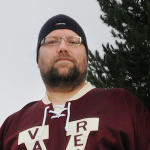 Brian Garbet has composed acoustic and electroacoustic music for film, theatre and concert. While at SFU, he was a Jeu de Temps/Times Play national prize winner with his composition Ritual. He has received airplay and performances across Canada, the United States, New Zealand and Finland.
Brian Garbet has composed acoustic and electroacoustic music for film, theatre and concert. While at SFU, he was a Jeu de Temps/Times Play national prize winner with his composition Ritual. He has received airplay and performances across Canada, the United States, New Zealand and Finland.
After years of touring and recording with the rock band Crop Circle, Brian completed his Master of Music at UBC. Currently a PhD candidate at the University of Calgary under the supervision of Laurie Radford, he has also studied with Barry Truax, Hildegard Westerkamp, Rodney Sharman, Bob Pritchard, Keith Hamel, and Allan Bell. Recently Brian returned from a research residency in the United Kingdom where he was working with Joseph Hyde, P.A. Tremblay, and Trevor Wishart.
Dr. Andrea Szigetvári (Liszt F. Academy of Music, Budapest) – Re-connecting and re-contextualizing image and sound in the multidimensional timbre space
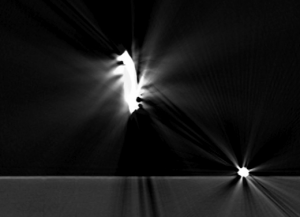 This article explores the connection of moving image and sound with the help of a software allowing real time navigation in multidimensional timbre space. The software was created to realize an interactive audiovisual piece CT. Its goal was to compose different sonic interpretations of similar visual gestures in order to particularize the expressivity of the moving image sequences.
This article explores the connection of moving image and sound with the help of a software allowing real time navigation in multidimensional timbre space. The software was created to realize an interactive audiovisual piece CT. Its goal was to compose different sonic interpretations of similar visual gestures in order to particularize the expressivity of the moving image sequences.
Recent technology makes video frames accessible for controlling interactive music performance. Movement and behaviour of objects on the video canvas can be interpreted with sound in very different ways furnishing them with different ‘personalities’ applying diverse, dynamically changing sonorities. In an interactive situation, Chion’s term synchresis can be extended to wider perspectives. The use of motion capture data can facilitate automatic accompaniment of the movement, whilst modifying the parameters of the sound generating unit can create different metaphoric distances between the image and sound.
The concept of limited timbre space was accommodated to create the sound generating unit for the piece. A modular system was conceived, whereby each module represented a set of timbre dimensions, thus creating a limited timbre space. The modules were combined together to form a more complex (although still limited) timbre space.
Navigation in the timbre dimensions is controlled with the frames of the video, which is performed in real time: it is the sequences of the frames can be controlled manually applying loops and random processes.
Biography
 Andrea Szigetvári is an electroacoustic music composer. Her creative and research work concentrate mainly on the role of the timbre in new music, synchresis in audiovisual art and interactive performance.
Andrea Szigetvári is an electroacoustic music composer. Her creative and research work concentrate mainly on the role of the timbre in new music, synchresis in audiovisual art and interactive performance.
She studied sound recording and electroacoustic music at Fr. Chopin Academy of Music in Warsaw. She was a Fulbright researcher in the USA at Brooklyn College and later at CCRMA, Stanford. She holds a DLA in composition from the Liszt F. Academy of Music Budapest. In 2001 she received two “Prix” of the a Bourges Electroacoustic Music Competition in ‘multimedia’ and ‘sound art’ categories.
She is the funder of the Hungarian Computer Music Foundation which aim is support contemporary electroacoustic music in Hungary. She has been the organizer and performer of many international collaborations, festivals, conferences.
She has taught electroacoustic music composition at the Liszt F. Academy of Music in Budapest, where she founded the Electronic Music Media Art Course in 2011.. She is the lecturer also at the Pécs University of electroacoustic music, at the Metropolitan University, Budapest at the Moving Image and Sound course.
Sama Mara – Musical Forms: The Rhythm of a Pattern
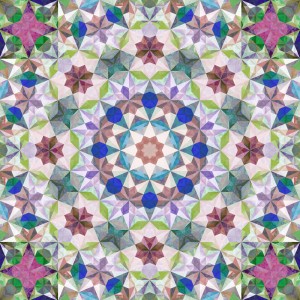 This paper explores the relationship between music and art. By implementing aspects from fractal geometry, aperiodic tilings and traditional geometry a new method is revealed where rhythm is translated into pattern allowing artworks to be read as musical scores and music to be represented in geometric form. The method explained here is the foundation of the project ‘A Hidden Order’ by Sama Mara and composer Lee Westwood.
This paper explores the relationship between music and art. By implementing aspects from fractal geometry, aperiodic tilings and traditional geometry a new method is revealed where rhythm is translated into pattern allowing artworks to be read as musical scores and music to be represented in geometric form. The method explained here is the foundation of the project ‘A Hidden Order’ by Sama Mara and composer Lee Westwood.
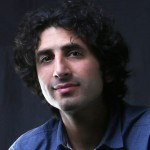 Biography Sama Mara is an artist and geometer based in London. He was awarded the Barakat Trust Prize at the Prince’s School of Traditional Arts where he graduated with an MA in Traditional Arts. He completed his BA in Music and Visual Performance in the University of Brighton. Sama has a wide range of skills and interests including traditional geometry, programming, painting, music theory, studio photography, video editing, fractal geometry and quasi-crystals, all of which inform, inspire, and enable his practice as an artist. His project A Hidden Order, made in collaboration with composer Lee Westwood, has seen his work exhibited across the globe including London, Istanbul, Abu Dhabi, Miami, Los Angeles, Toronto, Seoul and Jeddah.
Biography Sama Mara is an artist and geometer based in London. He was awarded the Barakat Trust Prize at the Prince’s School of Traditional Arts where he graduated with an MA in Traditional Arts. He completed his BA in Music and Visual Performance in the University of Brighton. Sama has a wide range of skills and interests including traditional geometry, programming, painting, music theory, studio photography, video editing, fractal geometry and quasi-crystals, all of which inform, inspire, and enable his practice as an artist. His project A Hidden Order, made in collaboration with composer Lee Westwood, has seen his work exhibited across the globe including London, Istanbul, Abu Dhabi, Miami, Los Angeles, Toronto, Seoul and Jeddah.